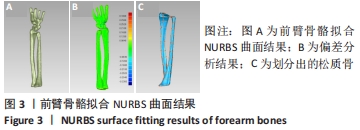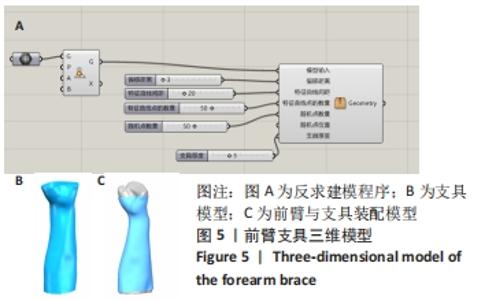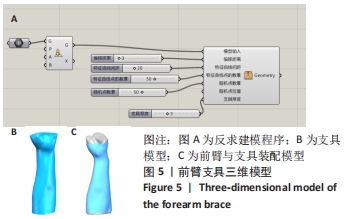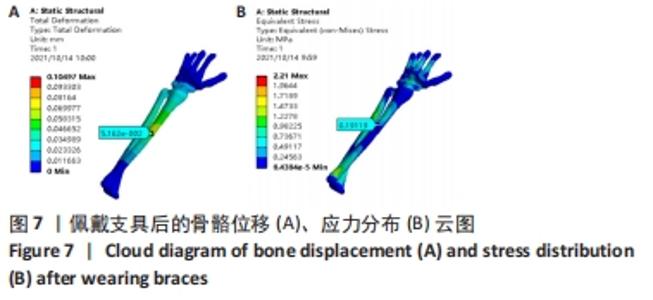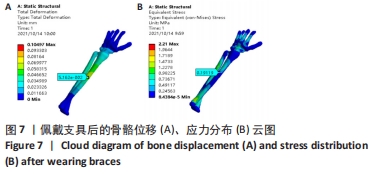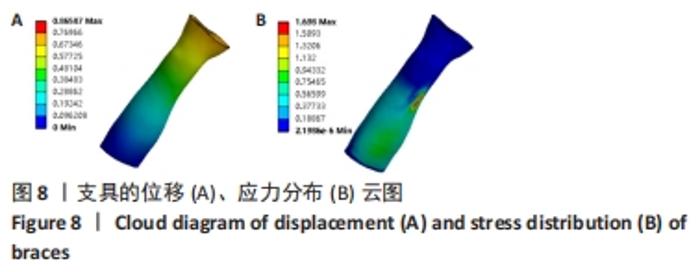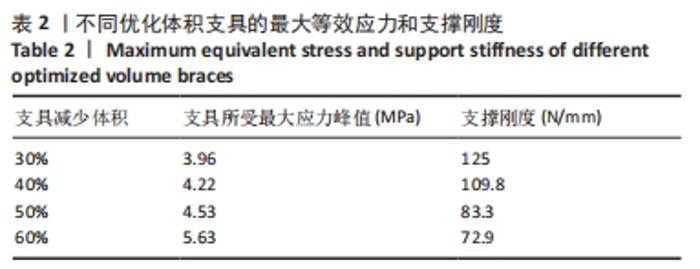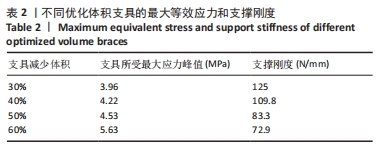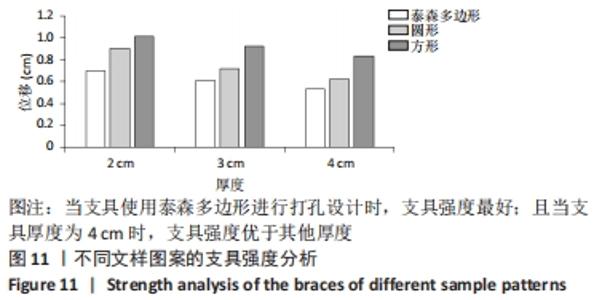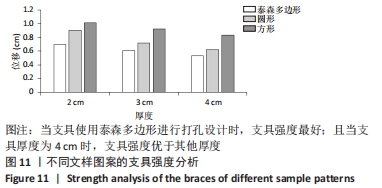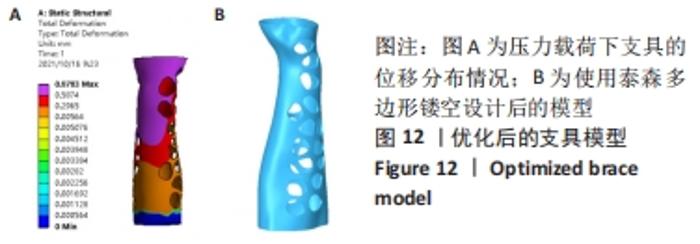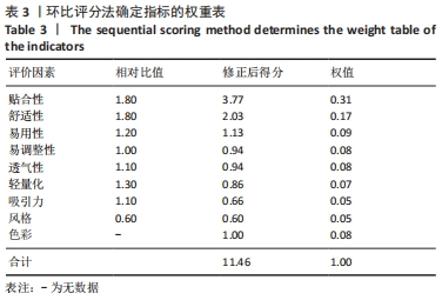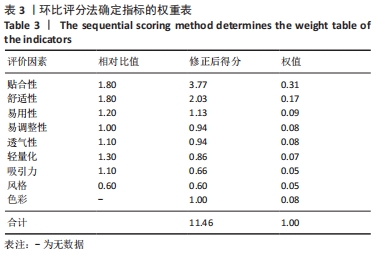Chinese Journal of Tissue Engineering Research ›› 2023, Vol. 27 ›› Issue (9): 1340-1345.doi: 10.12307/2023.208
Previous Articles Next Articles
Finite element analysis and structural optimization design of 3D printed forearm braces
Peng Zhixin1, Yan Wengang1, Wang Kun1, Zhang Zhenjiang2
- 1School of Mechanical Engineering, Inner Mongolia University of Technology, Hohhot 010000, Inner Mongolia Autonomous Region, China; 2Inner Mongolia Honorary Soldier Mutilation Rehabilitation Center, Hohhot 010000, Inner Mongolia Autonomous Region, China
-
Received:2021-12-08Accepted:2022-01-18Online:2023-03-28Published:2022-07-01 -
Contact:Yan Wengang, PhD, Associate professor, School of Mechanical Engineering, Inner Mongolia University of Technology, Hohhot 010000, Inner Mongolia Autonomous Region, China Wang Kun, PhD, Associate professor, School of Mechanical Engineering, Inner Mongolia University of Technology, Hohhot 010000, Inner Mongolia Autonomous Region, China -
About author:Peng Zhixin, Master candidate, School of Mechanical Engineering, Inner Mongolia University of Technology, Hohhot 010000, Inner Mongolia Autonomous Region, China -
Supported by:Industry-University Collaborative Education Fund of Ministry of Education in 2020, No. 2020002232006 (to WK); Natural Science Foundation of Inner Mongolia Autonomous Region, No. 2021LHMS05004 (to YWG)
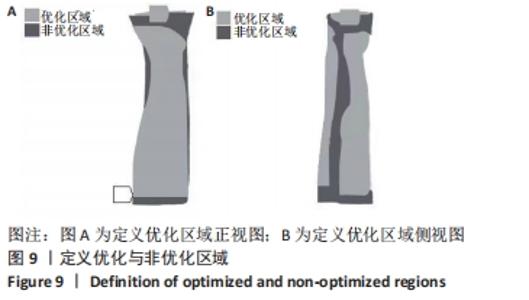
2.4 支具拓扑优化 支具的有限元分析结果显示,在外力载荷的作用下,最大变形区域位于前臂近端区域,在支具的末端区域也出现了应力分布,并且根据临床经验判断,支具的主要受力区是前臂腕部及前臂末端部分,因此在定义3D打印前臂外固定支具时要限定支具的前端、后端及支具的轮廓边界的部分,确定支具的优化设计区域以及非设计区域[27],见图9。通过分析表2,体积减少30%的支具刚度最优,但综合考虑支具透气性和支撑刚度问题,选取减少40%的体积为最优结果。再依据优化后结果对前臂支具结构进行设计打孔,使其既满足结构强度要求又能起到对前臂骨折的保护与稳定作用。用Grasshopper插件对支具进行打孔减材处理,减少支具质量的同时增加其透气性,优化后结果见图10。"

| [1] 高军茂,王鹏程,孙鹏,等. 前臂骨折的治疗进展[J].现代中西医结合杂志,2011,20(3):383-385. [2] HAMN MP, RICHTER D, MUHR G, et al. Forearm fractures in children Diagnosis, treatment, and possible complications. Der Unfallchirurg. 1997;100(10):760-769. [3] LOOSE O, FERNANDEZ F, MORRISON S, et al. Treatment of nonunion after forearm fractures in children: a conservative approach. Eur J Trauma Emerg Surg. 2021;47(2):293-301. [4] ELIA G, BLOOD T, GOT C. The Management of Pediatric Open Forearm Fractures. J Hand Surg. 2020;45(6):523-527. [5] BARTOLOTTA R, DANIELS S, VERRET C, et al. Current Fixation Options for Elbow, Forearm, Wrist, and Hand Fractures. Semin Musculoskelet Radiol. 2019;23(2):109-125. [6] WU JC, LILLY R, VARA AD, et al. Posttraumatic Bifid Ulna in a Pediatric Galeazzi-Equivalent Forearm Fracture. J Hand Surg. 2018;44(9):802-801. [7] 张妙林,高志朝,郑国富,等. 桡骨远端骨折闭合复位后再移位相关危险因素分析[J].中国骨与关节损伤杂志,2019,34(3):44-47. [8] CHA SM, SHIN HD. Risk factors for atypical forearm fractures associated with bisphosphonate usage. Injury. 2021;52(6):1423-1428. [9] TRIVELLAS M, HENNRIKUS W, GUPTA R, et al. Waterproof Cast Liners for Pediatric Forearm Fractures — a Comparison of Two Products. Trauma. 2020;23(1):51-53. [10] MUNTEANU A, CHITARIU D, CIOATA F. The FDM 3D Printing Application for Orthopedic Splints. Appl Mech Mater. 2015;809-810:375-380. [11] JANZING HMJ, BESSEMS SAM, LIGHTHART MAP, et al. Treatment of dorsally dislocated distal radius fractures with individualized 3D printed bracing: an exploratory study. 3D Print Med. 2020;6(1):22. [12] WEI Y, MAO D, XIAO BX, et al. Lightweight splint design for individualized treatment of distal radius fracture. J Med Syst. 2019;43(8):1-10. [13] 曾焘,高大伟,吴宇峰,等. 小夹板结合3D打印支具外固定治疗Colles骨折[J].中国骨伤,2019,32(6):513-518. [14] 张朝驹, 何川, 陈洪卫,等. 基于有限元模型分析伸直型桡骨远端骨折的生物力学特点[J].中国组织工程研究,2019,23(12):1898-1902. [15] BLAYA F, PEDRO PS, SILVA JL, et al. Design of an Orthopedic Product by Using Additive Manufacturing Technology: The Arm Splint. J Med Syst. 2018;42(3):54. [16] 阎金刚,张吉利,王建新,等. 基于逆向技术医疗外固定支具的设计[J].工业技术与职业教育,2021,19(1):21-23. [17] SANTONI BG, AIRA JR, DIZA MA, et al. Radiographic evaluation of acute distal radius fracture stability: a comparative cadaveric study between a thermo-formable bracing system and traditional fiberglass casting. Clin Biomech. 2017;47:20-26. [18] 刘非,邱冰,薛向东,等. 基于3D打印技术的个性化外固定支具设计[J].中国矫形外科杂志,2016,24(24):2260-2263. [19] 唐鹏程,朱英,赵敏珠,等. 肘关节有限元模型模拟碰撞损伤的生物力学特性分析[J]. 第三军医大学学报,2018,40(7):596-602. [20] HIRASHIMA T, MATSUURA Y, TAKANE SD, et al. Long-term Evaluation Using Finite Element Analysis of Bone Atrophy Changes after Locking Plate Fixation of Forearm Diaphyseal Fracture. J Hand Surg Glob Online. 2021;3(5):240-244. [21] HAMMER VB, OLHOFF N. Topology optimization of continuum structures subjected to pressure loading. Struct Multidiscip O. 2000;19(2):85-92. [22] 钟环,欧阳汉斌,魏波,等. 桡骨远端骨折锁定钢板的拓扑优化及有限元分析[J].中国矫形外科杂志,2018,26(23):2189-2194. [23] CHEN YJ, HUI L, HUANG WH, et al. Application of 3D-printed and patient-specific cast for the treatment of distal radius fractures: initial experience. 3D Print Med. 2017;3(1):11. [24] 杜丹丹,胡惠惠,周芳, 等. 层次分析法在确定麻醉护理专业学位硕士核心能力评价指标权重中的应用[J].护士进修杂志,2021, 36(19):1755-1759+1766. [25] 周晓宁. 腕关节三维有限元模型的建立及桡骨远端骨折发生机制的生物力学分析[D]. 北京:北京中医药大学,2014. [26] LU PC, LIAO ZW, CHEN H, et al. Customized Three-Dimensional-Printed Orthopedic Close Contact Casts for the Treatment of Stable Ankle Fractures: Finite Element Analysis and a Pilot Study. ACS Omega. 2021; 6(4):3418-3426. [27] DEATON JD, GRANDHI RV. A survey of structural and multidisciplinary continuum topology optimization: post 2000. Struct Multidiscip O. 2014;49(1):1-38. [28] 阿依古丽•喀斯木, 乌日开西•艾依提, 滕勇,等. 基于3D打印的手指屈肌腱损伤定制化支具设计[J]. 机械设计与制造,2017,55(11): 215-219. [29] 刘宁,刘宇,龚先政,等. 基于关联环比评分法的水足迹评价背景数据遴选模型研究[J].质量与认证,2021(6):65-68. [30] CUI X, LIANG L, ZHANG HY, et al. The effectiveness and safety of plaster splint and splints for distal radius fractures: A systematic review and meta-analysis of randomized controlled trials. Medicine. 2020;99(9):e19211. [31] ZHANG YF, GUAN TM, GUO QG, et al. Digital design of personalized scoliosis orthopedic braces based on 3D printing technology. Chin J Tissue Eng Res. 2019;23(36):5824-5829. [32] MASON-MACKAY AR, WHATMAN C, REID D, et al. The effect of ankle bracing on landing biomechanics in female netballers. Phys Ther Sport. 2016;20:13-18. [33] HUA Z, WANG JW, LU ZF, et al. The biomechanical analysis of three-dimensional distal radius fracture model with different fixed splints. Technol Health Care. 2018;26(2):329-341. [34] 魏成建,陶宝琛,张满臣,等. 动力气囊压垫纠正桡骨远端AO C3.1型骨折残余侧方移位的三维有限元分析[J].医用生物力学,2018, 33(1):13-17. [35] DESSERY Y, PALLARI J. Measurements agreement between low-cost and high-level handheld 3D scanners to scan the knee for designing a 3D printed knee brace. Plos One. 2018;13(4):e0196183. |
| [1] | Zhong Yizheng, Huang Peizhen, Cai Qunbin, Zheng Liqin, He Xingpeng, Dong Hang. Microstructural indexes that determine the trabecular bone maximum stress of micro-finite element models [J]. Chinese Journal of Tissue Engineering Research, 2023, 27(9): 1313-1318. |
| [2] | Wu Taoguang, Nie Shaobo, Chen Hua, Zhu Zhengguo, Qi Lin, Tang Peifu. Biomechanical characteristics of a new multi-dimensional cross locking plate in the treatment of subtrochanteric nonunion [J]. Chinese Journal of Tissue Engineering Research, 2023, 27(9): 1330-1334. |
| [3] | Wu Tianliang, Tao Xiuxia, Xu Hongguang. Influence of different bone mineral densities on cage subsidence after stand-alone oblique lateral interbody fusion: three-dimensional finite element analysis [J]. Chinese Journal of Tissue Engineering Research, 2023, 27(9): 1352-1358. |
| [4] | Liu Jinyu, Zhang Hanshuo, Cui Hongpeng, Pan Lingzhi, Zhao Boran, Li Fei, Ding Yu. Finite element biomechanical analysis of minimally invasive treatment of cervical spondylotic myelopathy and accurate exercise rehabilitation [J]. Chinese Journal of Tissue Engineering Research, 2023, 27(9): 1359-1364. |
| [5] | He Yujie, Kang Zhijie, Xue Mingming, Jin Feng, Li Zhijun, Wang Xing, Xu Yangyang, Gao Mingjie, Li Jiawei, Li Xiaohe, Wang Haiyan. Finite element analysis of transarticular screw fixation of adolescent thoracic vertebra [J]. Chinese Journal of Tissue Engineering Research, 2023, 27(9): 1365-1370. |
| [6] | Wen Xinghua, Ding Huanwen, Cheng Kai, Yan Xiaonan, Peng Yuanhao, Wang Yuning, Liu Kang, Zhang Huiwu. Three-dimensional finite element model analysis of intramedullary nailing fixation design for large femoral defects in Beagle dogs [J]. Chinese Journal of Tissue Engineering Research, 2023, 27(9): 1371-1376. |
| [7] | He Yinhao, Li Xiaosheng, Chen Hongwen, Chen Tiezhu. 3D printed porous tantalum metal in the treatment of developmental dysplasia of the hip: current status and application prospect [J]. Chinese Journal of Tissue Engineering Research, 2023, 27(9): 1455-1461. |
| [8] | Wang Yanjin, Zhou Yingjie, Chai Xubin, Zhuo Hanjie. Meta-analysis of the efficacy and safety of 3D printed porous titanium alloy fusion cage in anterior cervical discectomy and fusion [J]. Chinese Journal of Tissue Engineering Research, 2023, 27(9): 1434-1440. |
| [9] | Liu Qinghua, Cai Yongqiang, Jin Feng, Yu Jinghong, Wang Haiyan, Zhang Yunfeng, Wang Lidong, Li Jiawei, Wang Xing, He Yujie, Dai Lina, Wang Jianzhong, Wu Chao, Tong Ling, Kang Zhijie, Li Zhijun, Li Xiaohe. Finite element model of the 12-year-old child whole cervical spine: establishment and validity verification based on CT data [J]. Chinese Journal of Tissue Engineering Research, 2023, 27(4): 500-504. |
| [10] | Li Yaping, Liu Hong, Gao Zhen, Chen Xiaolin, Huang Wujie, Jiang Zheng. Three-dimensional motion analysis of lower limb biomechanical performance in Tai Chi practitioners accompanied by knee joint pain [J]. Chinese Journal of Tissue Engineering Research, 2023, 27(4): 520-526. |
| [11] | Li Shihao, Li Qi, Li Zhen, Zhang Yuanyuan, Liu Miaomiao, Ouyang Yi, Xu Weiguo. Plantar pressure and gait analysis in patients with anterior cruciate ligament injury and reconstruction [J]. Chinese Journal of Tissue Engineering Research, 2023, 27(4): 626-631. |
| [12] | Chai Hao, Yang Deyong, Zhang Lei, Shu Li. 3D printing personalized osteotomy guide technology versus conventional total knee arthroplasty on the accuracy of lower limb force alignment: a meta-analysis [J]. Chinese Journal of Tissue Engineering Research, 2023, 27(4): 646-654. |
| [13] | Zhai Hongjie, Han Guanda, Li Lei, Dong Xiaohui, Jiang Zhiquan, Lou Feiyun. 3D printed polyetheretherketone material for skull defect repair [J]. Chinese Journal of Tissue Engineering Research, 2023, 27(3): 380-384. |
| [14] | Zhan Yi, Wang Biao, Ma Yuli, He Simin, Sun Honghui, Hao Dingjun. Biomechanical comparison between a novel bone cement screw system and common surgical methods for the treatment of Kummell’s disease [J]. Chinese Journal of Tissue Engineering Research, 2023, 27(3): 385-390. |
| [15] | Lu Hui, Wu Qimei, Liu Rong. Finite element analysis and application of unilateral and bilateral bone-filling mesh container in treatment of osteoporotic vertebral compression fracture [J]. Chinese Journal of Tissue Engineering Research, 2023, 27(3): 391-397. |
| Viewed | ||||||||||||||||||||||||||||||||||||||||||||||||||
|
Full text 389
|
|
|||||||||||||||||||||||||||||||||||||||||||||||||
|
Abstract 794
|
|
|||||||||||||||||||||||||||||||||||||||||||||||||



